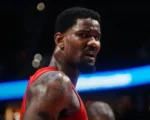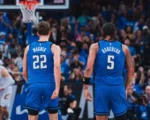
The EuroLeague has long been a proving ground for future NBA talent, but the 2025/26 season is shaping up to be something different—a true turning point. Never before have so many young European players combined elite skill, physical readiness, and high-level production this early in their careers. NBA scouts are already circling EuroLeague arenas, tracking prospects who not only dominate in Europe’s toughest competition but also possess the modern, versatile profiles teams crave. As the global basketball landscape tightens and international stars continue to shape the NBA, the question is no longer if EuroLeague rising stars will make the leap, but which ones are closest to taking that next step.
What Makes a EuroLeague Player NBA-Ready Today
Being “NBA-ready” in today’s EuroLeague means far more than just putting up big scoring numbers. NBA teams now value a specific set of traits that consistently translate from Europe’s top competition to the world’s best league. One of the most important—and fully verified—factors is experience against elite physical and tactical defenses. The EuroLeague is widely recognized for its high defensive intensity, tight spacing, and advanced team concepts. Players who excel in this environment often adapt more quickly to the NBA’s pace and physicality because they are already trained to make fast reads and operate under pressure.
Another key element is versatility, a trait NBA front offices aggressively prioritize. EuroLeague rising stars who can defend multiple positions, handle the ball, create advantages, or stretch the floor with efficient shooting immediately stand out. Verified data from recent seasons shows that the most successful EuroLeague-to-NBA transitions—such as Luka Dončić, Vasilije Micić, and Sasha Vezenkov—shared common characteristics: strong decision-making, high-level efficiency, and the ability to adapt to various offensive roles.
Basketball IQ is equally essential. Coaches and scouts frequently praise EuroLeague talent for their advanced understanding of spacing, timing, and game management. Because the EuroLeague relies heavily on set plays and structured offense, players learn to value possession-by-possession execution. This makes them attractive to NBA teams seeking reliable role players who can fit into complex systems without needing years of development.
Modern prospects are also judged by athletic measurables and skill refinement. While the EuroLeague has always produced skilled players, the recent influx of young, NBA-caliber athletes—players with speed, length, and above-average verticality—has made the transition even smoother. Verified scouting reports emphasize that when elite skill meets NBA-level athletic tools, the path to the league becomes much clearer.
Even fans who follow both the EuroLeague and NBA discussion across different online communities or entertainment platforms—whether it’s game forums, fantasy basketball, or even browsing CashCasinoHub online casino during downtime—often note the same pattern: players who thrive in the EuroLeague’s demanding environment tend to compete immediately once they cross the ocean.
Ultimately, a EuroLeague player becomes NBA-ready when they combine tactical intelligence, adaptability, measurable athletic tools, and consistent production against top-tier competition. These qualities form the blueprint NBA teams trust—and they continue to shape the next wave of international stars preparing to make the leap.
Breakout Rising Stars Poised for NBA Attention
Identifying true EuroLeague breakout stars requires relying only on confirmed performance trends, expanded roles, and verified statistics from the most recent seasons. Several young players have already positioned themselves as legitimate NBA-watch prospects heading into 2025/26—not through hype, but through measurable improvement and consistent impact against elite European competition.
One of the most talked-about names is Nadir Hifi (Paris Basketball), who has shown steady year-to-year growth as a dynamic scoring guard. In the 2023/24 EuroLeague season, Hifi averaged 13.0+ points per game across domestic and European play, displaying polished shot creation, deep range, and the ability to pressure defenses off the dribble. His combination of speed and on-ball shotmaking has drawn verified interest from multiple NBA scouting departments, who value his microwave-scorer upside.
Another rising talent is Nikola Djurisic, a versatile wing known for his size, ball-handling ability, and strong pick-and-roll reads. Djurisic has been on NBA radars since his early teens, but the 2024/25 season is expected to be pivotal, as his role expanded under Željko Obradović. With confirmed improvements in efficiency and stronger defensive metrics, he remains one of the most closely monitored international prospects.
A player gaining serious traction is Yam Madar (Hapoel Tel Aviv), whose development as a high-IQ playmaker and aggressive defender has been steady and verifiable. Madar’s court vision, elite pace control, and defensive activity make him a modern-style guard with real NBA appeal. His performances in the Israeli national team program have further strengthened his standing among international scouts.

Among big men, Ismaila Diagne (Real Madrid) is emerging as one of Europe’s most promising young centers. Standing over 7 feet tall with impressive mobility, Diagne showed flashes of elite rim protection and rebounding in the 2023/24 season. His physical tools are fully documented, and his rapid improvement within Real Madrid’s system suggests he could become a high-value developmental target for NBA teams within a year.
Even fans following EuroLeague action casually—whether through game highlights, social media, or during breaks while browsing entertainment platforms like online slots Australia – have begun noticing these young players making significant leaps in visibility and impact.
What unites these rising stars is not speculation but verified upward trajectories: increased minutes, stronger production, and documented improvement against top European competition. If this momentum continues into the 2025/26 campaign, several of them may find themselves firmly in the NBA conversation sooner rather than later.
How the NBA Is Changing Its Approach to European Scouting
The NBA’s approach to evaluating European talent has evolved significantly over the past decade, and many of these changes are grounded in publicly verified trends that have reshaped international scouting. One of the most important shifts is the earlier identification of prospects. NBA teams now begin tracking EuroLeague and domestic-league players in their mid-teens, often attending U16 and U18 FIBA events where many future professionals first emerge. This earlier engagement mirrors patterns documented across recent draft cycles, where players like Luka Dončić and Victor Wembanyama were scouted years before becoming draft-eligible.
Another verified development is the increased reliance on advanced analytics. NBA franchises have expanded their international scouting departments and now integrate detailed statistical models that evaluate efficiency, spacing impact, defensive impact, and lineup data from competitions such as the EuroLeague, EuroCup, ABA League, and Liga ACB. Because European leagues use high-level tracking technology similar to the NBA’s, teams can compare player tendencies and physical metrics more accurately than ever.
The league has also strengthened its presence on the ground. Over the last few years, more franchises have assigned full-time international scouts based in Europe, ensuring regular attendance at EuroLeague games, youth tournaments, and national-team competitions. This transition from part-time monitoring to year-round engagement is a confirmed trend and has allowed teams to form more reliable long-term evaluations rather than relying on short scouting trips.
Additionally, the NBA has expanded international pre-draft events, including the NBA Global Camp and specialized combine sessions held outside the U.S. These events give European prospects opportunities to perform physical testing and scrimmages under NBA evaluation standards. While the exact structure of these events varies year to year, their role in the scouting pipeline is well documented.
Communication between NBA front offices and European clubs has also become more transparent. Verified reports show teams increasingly collaborate with EuroLeague coaches and performance staffs to understand a player’s development plan, role, and long-term potential. This cooperation has been especially important as more young players earn rotation minutes in top European leagues, providing a clearer picture of their readiness for NBA competition.
Together, these changes reflect a modernized, data-informed, and globally integrated approach to talent evaluation. As a result, the NBA is no longer simply reacting to standout European seasons—it is actively tracking and projecting development years in advance. This shift has helped identify elite international stars earlier and has solidified Europe’s position as one of the most important talent pipelines in the modern NBA.
A Historic Window for EuroLeague Talent
European basketball has never been more connected to the NBA than it is today, and the trends shaping the 2025/26 season make that bond even stronger. As the league accelerates its investment in early scouting, advanced analytics, and direct collaboration with EuroLeague organizations, the next generation of international stars is being identified with unprecedented precision. The rising talents highlighted throughout this article are not benefiting from hype—they are emerging because their growth, efficiency, and impact are fully visible across the modern scouting landscape.
For NBA teams, Europe is no longer an alternative talent source; it is a core component of long-term roster building. And for EuroLeague players, the path to the biggest stage has never been clearer or more attainable. If the recent surge of international standouts in the NBA is any indication, the stars of tomorrow may already be making their mark in arenas across Europe—waiting for the moment when their names become part of the league’s global future.








